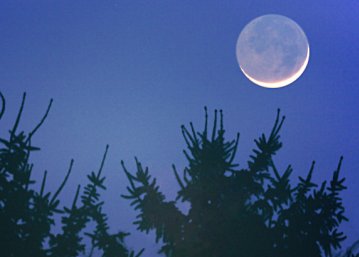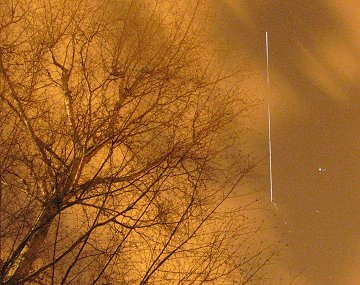| Where's Saturn? Is that a UFO--or the ISS? What's the name of that star? Get the answers from mySKY--a fun new astronomy helper from Meade. | |  | MOONBUGGY RACE: Contestants in NASA's 15th Annual Great Moonbuggy Race have crossed the finish line, and the winner is.... Read today's story from Science@NASA to find out who crashed and who triumphed in the adventurous competition. LUNA AND THE SEVEN SISTERS: Cast an eye over the photo below and, using your imagination, insert to the left of the crescent Moon a sparkling star cluster. Too good to be true? It's going to happen on April 8th when the crescent Moon glides by the Pleiades: sky map. 
Photo credit: Alexander Birkner of Eppelborn, Germany: more
Also known as the Seven Sisters, the Pleiades are a cluster of stars 400 light years from Earth. The brightest seven of these blue-white beauties form a little dipper visible to the naked eye even from urban areas. The Moon will come so close to the Pleiades, they almost overlap! To see this delicate conjunction, go outside after sundown, face west and locate the Moon. Scan the area around the crescent with binoculars and you will see not just seven but dozens of sparkling stars, some winking in and out coquettishly behind the mountainous lunar limb. Be careful, though, this kind of beauty can be perilous. more images: from Mark D. Marquette of Johnson City, Tennessee; from Gilles & Camille Dawidowicz of Corbeil-Essonnes, France; from Günther Strauch of Borken, NRW, Germany; from Geir Øye of Ørsta, Norway; from Oana Suciu of Turda, Romania; from Elias Chasiotis of Athens, Greece; from Antonios Pantelidis of Florina, Greece; from Peter Pulles of the Netherlands; from Pavel Klimes of Hostivice, Czech Republic; from Jim Kurtz of Kalamazoo, Michigan; from Etienne Lecoq of Normany, France; BRIGHT SPACESHIP: The International Space Station is growing. In the past six months alone, astronauts have unfurled 230-ft solar wings, added a 30,000-lb docking port (Harmony), installed a 28,000-lb science lab (Columbus) and, while they were at it, a European robot ship (Jules Verne) flew up to the ISS and docked itself. It all adds up to a spaceship so big and bright, it shines right through the clouds: 
"April 4th was a cloudy night, but the space station was easy to see," says Dave P. Smith who took the picture from Bluebell Hill, Kent, England, using his Canon PowerShot A540. "Lights shining upward from town made the clouds orange," he explains. Later this week, scenes like this will appear over North America. On April 9th the space station begins an 8-day series of bright evening flybys. Canadian and US readers can find out when to look using our new Simple Satellite Flybys tool. more images: from Jacob Kuiper of De Bilt, The Netherlands; from Pavel Klimes of Hostivice, Czech Republic; from Zoltan Kollath at the Zselic Landscape Protection Area, Hungary
March 2008 Aurora Gallery
[Aurora Alerts] [Night-sky Cameras] | 
